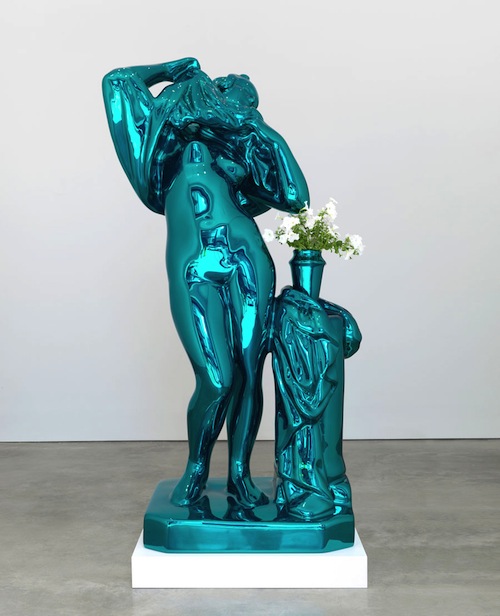
"JEFF KOONS: New Paintings and Sculpture" (Image courtesy of Gagosian. Installation view Photo by Rob McKeever)
We may know all we’d ever need to know about Jeff Koons at this point. Leading up to his current exhibition in Chelsea, a New York Magazine cover profile re-declared him the most successful living artist since Warhol, and visitors to Frieze New York were confronted with a rubber spectre of his massive balloon dog, a knock-off by Paul McCarthy. Rumors of Koons leaving Gagosian for Zwirner even sparked murmurs that the world’s most powerful art dealer had finally hit his Achilles heel. Now open, two outrageously exorbitant shows at Gagosian and David Zwirner remind us of the one thing we’re not hearing about– why he’s so successful in the first place.
Basically, he’s a great artist. At Gagosian, we see Koons the exhibitionist, with massive Photoshop-style oil paintings and polychromed bronzes which boil all of art history down to penis and vagina, the same puerile flamboyance as his pornographic 1992 show “Made in Heaven”. Hung around a chrome Venus of Willendorf balloon, paintings of Greco-Roman nudes are overlaid with symbols of virility. You’ll find everything from ancient fertility statues to Abstract Expressionism to the Superman logo. Aphrodite is sourced only for her nice ass. Koons squiggles a sepia doodle over each image, resembling both a sailboat and vagina, or a massive artist’s signature. He even turns the sexualizing lens on his own work; three of his signature eleven-foot-tall balloon animals look less like animals than hermaphroditic genitalia.
Art, as Koons creates it, is a playground. Arguably, this aligns with his desire to push against the kind of art that makes people feel inferior; empowerment comes into play. In the back room,a life-sized bronze of an inflatable balloon Hulk charges a replica of an antique King Kong toy with a wheelbarrow of petunias. The theatrical set-up detracts from their individual strengths, which otherwise would work well for Koons; the mass production of toys necessitates an oafish mark-making which helps them become symbols of brute force. The work is impossible to communicate in a photograph, because standing eye-to-eye really makes you feel your own size. As contrary as it seems to Koons’ powerful persona, it’s about transcending class; the middle class gets to be shiny, the upper class gets to be sluts.

JEFF KOONS Metallic Venus, 2010–12 Mirror-polished stainless steel with transparent color coating and live flowering plants 100 x 52 x 40 inches (254 x 132.1 x 101.6 cm) Ed. of 3 (Image courtesy of Gagosian)
Nailing the point home, a polychromed Venus pulls up her dress to the street outside. It’s pure exhibitionism, the kind that makes you very successful in Chelsea, or anywhere; at the same time, she’s stepping off her pedestal. In that sense, the dick doesn’t seem so much about being a man, as it is about being an individual. Genitalia stands like a testament to the self, like a giant signature. Koons does an excellent job at communicating this, as many artists do at Gagosian.
Lest you think that Koons is too much of a capitalist to express sensitivity, Zwirner gets the soul to Gagosian’s groin. Koons seems to have taken a palmful of blue gazing balls and blown them out into the gallery, landing on classical statues and Midwestern lawn ornaments, which have coalesced in pure white plaster. The purity, and ceiling-height scale, conveys the transcendent feeling of finding a crystal clear lake in the woods. Some of the balls have found shoulders, and in one particularly breathtaking case, perched on the curve of the thigh of the self-loving Barberini Faun. As exquisite as the statues are, even down to the inflatable snowman’s cloth scarf, the white plaster is completely overpowered by the looming presence of mirrored blue; you look into them for a higher power, but all you can see it yourself. Whereas you could write off the Gagosian show as a typical Koons stunt, it’s impossible to look at the one at Zwirner without asking yourself some questions.

Screen shot from David Zwirner's installation video for "Gazing Ball" (Image courtesy of David Zwirner)
Koons describes them as embodying “affirmation, generosity, sense of place, and joy of the senses,” but I don’t agree. Maybe I’m projecting, but they feel critical, and the balls are always a little off-center, so you never feel quite grounded. It’s easy to fall into the high-art wormhole of The Gaze, but even in all of its extravagance, this sits somewhere closer to earth, with additional plaster mailboxes, a mailbox topped with a motor, and an oyster birdbath. The gazing ball which sits atop the row of mailboxes, in particular, speaks more to suburban mid-life crisis than the sublime. It’s really wonderful.
That’s something a lot of people can relate to, a common thread in his work, perhaps best exemplified by the objects about selfhood. Self-love is easy to like, which probably explains the mainstream popularity of characters like Koons in the first place. Certainly for some, it reinforces Ayn Randian attitudes about individual success. But as a whole, Gazing Ball serves as a metaphor for the best of Koons’ work: you’re not really considering a balloon, or a bronze, but an externalized experience shared by everyone. The idea’s privileged, but it’s bigger, at least, than even Jeff Koons.


{ 2 comments }
LOVE it.
Lol thanks!
Comments on this entry are closed.